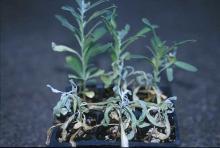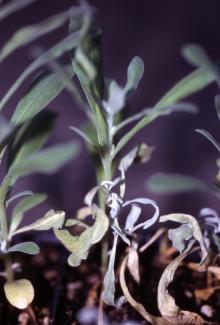Cause Xanthomonas campestris pv. incanae, a bacterium that persists in the soil, on or in seed. A vascular disease of the main stem and lateral branches. It often extends into leaf petioles and seed peduncles. Bacteria may be spread rapidly by splash from irrigation water. Cool wet weather favors infection and disease development. Yield losses of up to 90% have been experienced.
Symptoms Seedlings suddenly wilt when 2 to 4 inches tall. Stem tissues become yellowish, soft and mushy. A yellow exudate may occur along the stem but this is rare. On older plants, dark water-soaked areas appear around leaf scars near ground level. The stem may become girdled and lower leaves show veinal necrosis, turn yellow and drop. Entire plants may wilt or become broken by wind at ground level.
Cultural control There seem to be few if any effective controls for this disease.
- Start with pathogen-free seed.
- Seed can be treated with a dilute bleach solution (10%) for 10 minutes. Be sure to test a small batch of seed for sensitivity to these treatments.
- Treat seed with hot water (127°F to 131°F) for 10 min. followed by rapid cooling. Unfortunately, this has a strong negative impact on seed germination.
- Remove and destroy infected plants and debris.
- Avoid splashing overhead irrigation.
- Rotate planting beds for 2 to 3 years.
Chemical control Copper-based (Group M1 fungicides) or phos acid-based (Group P7 fungicides) products may be of some benefit. Several products may legally be used. Test first on a small section before applying on the whole plant to evaluate possible phytotoxicity.
Reference Ecker, R., Zutra, D., Barzilay, A., Osherenko, E., and Rav-David, D. 1995. Sources of resistance to bacterial blight of stock (Matthiola incana R. Br.). Genetic Resources and Crop Evolution 42:371-372.



